Brussels
Brussels (French: Bruxelles, Dutch: Brussel) is the capital of Belgium and one of the three administrative regions within the country, together with Flanders and Wallonia. Apart from its role within its country, it is also an internationally important city, hosting numerous international institutions, and in particular the core institutions of the European Union. Due to that, it is sometimes referred to informally as the capital of the EU, and even used as a metonym for the EU institutions.

Brussels blends the heritage of a medieval Flemish town with the grandiose projects initiated after it became the capital of what was then a French-speaking country, as well as some impressive modern architecture erected in a large part to house the international institutions. Brussels is now bilingual, hosting and officially recognizing the Dutch- and French-speaking communities of Belgium, and has become increasingly international with the influx of people of various origin who came there to work, many of them for the European Union. This all makes Brussels a rather unique blend, sprinkled with a number of Belgian peculiarities, and for the inquisitive tourist a large treasure chest to discover.
Districts
| Centre The small medieval centre of Brussels, with at its heart the Grand Place, the most beautiful square in the world and |
| Pentagon Following the outline of the second city walls, the Pentagon encloses the core city with its numerous restaurants, bars, museums, and other fascinating secrets to discover. The Pentagon is small enough to be explored by foot, and doing so is highly recommended. |
| European Quarter The heart of Flemish, Belgian, and European politics. The European Quarter is home to the European Parliament, the European Commission, and all other European institutions. The Jubilee Park at its eastern side is the background of museums well worth visiting. |
| Heysel (Laken, Neder-Over-Heembeek) Heights to the north of the city with remnants of the 1935 and 1958 World's Fairs scattered around, the most famous of which is the Atomium. In the shadow of the Atomium, Mini Europe and the Kinepolis cinema complex gave the Heysel its reputation as Brussels' leisure district. |
| Business District Brussels' high rise district to the north of the Pentagon, with modern skyscrapers, generic shopping opportunities, ethnic restaurants, and overpriced veggie bars. The district has little touristic value aside from the North Station, with its impressive Art Déco architecture. |
| Woluwe (St-Lambrechts-Woluwe, St-Pieters-Woluwe, Oudergem, Etterbeek, Watermaal-Bosvoorde, Elsene) Laid back residential area on the east side of the city, bordering Kraainem to the east and Tervuren to the south. It boasts a variety of architectural styles to explore, most notably houses by famous Art Nouveau architect Victor Horta, which are listed as |
| Matongé Home to much of Brussels' Congolese population. Worth a visit for the distinct African vibe, the colorful outfits that go with it, and the many African specialties that can be purchased in this neighbourhood. |
| North-East (Evere, Haren) A residential and commercial district that is also the home base of the NATO headquarters. Otherwise of relatively little interest to the average traveler, safe some nice parks. |
| South (Uccle, Vorst) Upscale residential district bordering the Sonian Forest to the south. Home of the Avenue Louyise, widely regarded as Brussels fanciest avenue. |
| West (Anderlecht, St.-Agatha-Berchem, Jette, Ganshoren, Koekelberg) Mainly a residential and commercial district. Towards the border with Flanders fairly rural, with forests, space for agriculture, and the restored Luizen windmill. The Koekelberg Basilica, the 5th largest church in the world, can be seen from almost everywhere, and absolutely worth a visit. |
| Sonian Forest The Sonian Forest is the largest natural area in Brussels, although only a small part of it is geographically within the boundaries of the Brussels Capital Region. Its endless beech trees covering rolling hills offers opportunities for jogging and cycling. If you get up early enough, you have a good chance of spotting wild deer and other wildlife! The Ter Kameren Park to the north is a popular leisure destination for locals. The Sonian Forest is inscribed as |
| International District (Molenbeek, Anderlecht, St.-Gillis, Vorst) A residential area in the south of Brussels with a high immigrant population. Part of it, Molenbeek, is known for being the origin of terrorists responsible for attacks in Brussels and Paris. The district has in the past played an important commercial role in the city. Nowadays, however, it is best not to go into this district at night. |
| Schaarbeek (Schaarbeek, St.-Joost-Ten-Node) Once a prosperous commercial hub, Schaarbeek and its surrounding suburbs have decayed to a hotspot of crime. While things have slowly begun to improve, it should still be visited with caution. The St.-Joost suburb is the poorest neighbourhood in Belgium, and its only attraction is — rather unsurprisingly — the Brussels red light district. |
| Industrial District A thin strip of commercial and industrial zones following the harbor from the Business District to Vilvoorde north of Brussels, and hosting the largest railway hub in Belgium. With little to see and do, deserted at night, and an unpleasant atmosphere of industrial decay after sunset, it is recommended to avoid this district. |
Understand
|
Autonomy of Brussels Within the Belgian federation, Brussels enjoys a large degree of autonomy. Although dependent on Belgium for matters such as defense and foreign policy, Brussels has its own government in charge of interior affairs, environmental policies, health care, economy, transport, tourism and education, and its own laws regarding these matters. The city has control over its own administrative region (the Brussels Capital Region), which is on the same level as Flanders and Wallonia in Belgium. This status of a city state within a host country is somewhat comparable to Vatican City and Hong Kong. The political autonomy of Brussels has drawn international interest as the host for politically independent entities such as the European Institutions (the European Commission and European Parliament), and the NATO headquarters. Brussels is a strongly internationally oriented metropolis, and despite shared languages, inhabitants identify as Brusseleirs rather than Flemes or Walloons. |
When Brussels became the capital city of a new country in the 19th century, large parts of the old town were destroyed to make way for brand new ministries, palaces, schools, army barracks and office blocks constructed between 1880 and 1980. The medieval city walls that once defended and surrounded the city were demolished. Only a small historic centre (one square and four adjacent streets) was preserved. The historic Flemish town centres are better preserved in cities like Antwerp, Bruges, Ghent, Leuven, and Mechelen. This thoughtless treatment of historic buildings has earned past city planners near-universal scorn and even given rise to the term "Brusselization" for cities that similarly tear down old buildings, replacing them with faceless concrete monstrosities.
Language
Language in Brussels can be a confusing matter to visitors. The common language is French, with around 90% of the population in Brussels speaking it passably to fluently. You can easily get by with English, especially in the tourist areas. Dutch is also an official language: within Brussels, the population that speaks Dutch passably to fluently is limited to around 20%, though Dutch-speakers make up the majority of Belgium as a whole. Because Brussels is the country's capital, when it comes to official matters, French and Dutch have equal status in Brussels, with sometimes complicated rules to ensure a balance between the two. Streets, railway stations, bus stops and other places have names in the two languages. The two names don’t always sound or look similar. For example, the Brussels-South railway station is Bruxelles-Midi in French and Brussel-Zuid in Dutch. Watch out when making assumptions based on English: a common mistake is to think Bruxelles-Midi refers to the Brussels-Central railway station, due to midi seeming similar to middle. Areas outside of Brussels have only one official language, but may still have distinct names in the other language. For example, you may get a train ticket that lists Anvers (in French) as the destination, but the signs in the station there will only say Antwerpen (in Dutch). In Brussels, large segments of the population have neither French nor Dutch as their mother tongue, and many other languages can be heard on the street, with Arabic being particularly common.
Historically Dutch-speaking, Brussels became more and more French-speaking during the 19th and 20th centuries. Today, most inhabitants speak French in daily life. Some numbers say that more than half of the inhabitants of Brussels do not speak French at home. The Brussels dialect, a Brabantian dialect of Dutch, can be heard, especially in the outer districts of Brussels Capital Region. The French spoken is standard French. Dutch speakers speak standard Dutch but many also speak a dialect when talking to people from their region.
English has become a common spoken language because of the international institutions based in Brussels, such as the European Commission, the European Parliament and NATO. It is still relatively rare to find written tourist or general information in English, although the situation is changing. One can expect public announcements in train stations to at least be said in French and Dutch, while larger train stations (such as Zuidstation/Gare du Midi) typically include English and German. English is also used on metros, trams and buses, announced last for information such as line transfers and terminal stops. Do not hesitate to ask someone if you do not understand what has been said.
Considering the city's location and that it markets itself as the capital of Europe, spoken English is less prevalent in Belgium than in its Dutch neighbour. However, even if it is not as widely spoken as one may expect, it is nonetheless widely understood. As is often the case elsewhere, success in finding someone who speaks English depends on several factors such as age (14-35 year-olds are most likely to speak English), education and previous experience abroad.
German is also an official language in Belgium spoken as a mother tongue by about 70,000 people in the east of the country bordering Germany, but the only German you're likely to hear in Brussels would be overheard on the streets around the European institutions or by German tourists, even if there is a large German population residing there.
Other languages that are increasingly heard in Brussels include Arabic (at least 25% of Brussels' population is of Arab descent, chiefly from Morocco), Spanish, Italian, Portuguese, Polish, and Russian.
Climate
| Brussels | ||||||||||||||||||||||||||||||||||||||||||||||||||||||||||||
|---|---|---|---|---|---|---|---|---|---|---|---|---|---|---|---|---|---|---|---|---|---|---|---|---|---|---|---|---|---|---|---|---|---|---|---|---|---|---|---|---|---|---|---|---|---|---|---|---|---|---|---|---|---|---|---|---|---|---|---|---|
| Climate chart (explanation) | ||||||||||||||||||||||||||||||||||||||||||||||||||||||||||||
| ||||||||||||||||||||||||||||||||||||||||||||||||||||||||||||
| ||||||||||||||||||||||||||||||||||||||||||||||||||||||||||||
Brussels' weather deservedly has a poor reputation. Rainfall is frequent and fairly evenly distributed over the seasons, although spring (March - May) and autumn (September - November) tend to see the most rain. With an annual rainfall of 820 mm spread over approximately 200 rainy days per year, the city gets to endure more rain than neighboring capitals Paris or London, and that regular rainfall makes the climate damp. Under high humidity, the rare warm days tend to feel uncomfortably hot, and the many cold days feel colder than elsewhere.
The best season to visit Brussels would be from late spring to early autumn, generally half May to half September would yield the highest chance of sunny weather. However, even the summer months are not immune from rain and can be very unpredictable: you can be lucky and enjoy a few dry days, but there is an equal chance you'll be confronted with rain for days on end. Bring ample waterproof clothes, preferably with long sleeves. Wet clothes don't dry easily in Brussels' humid climate and infrequent sunshine, so if you get wet, you'll probably have to sustain damp clothes for the rest of the day. An umbrella is an essential accessory in every season! Daily temperature variations are always below 10°C, so you typically don't have to worry about changing into something warmer/cooler over the course of the day. In summer, the average temperature is about 22°C, but don't take it as clothing advice: one week you might experience autumn weather and 15°C, and the next you might (briefly) enjoy 30°C or more! After October, temperatures drop off quite quickly, and sunny days become rare (In December 2017, Brussels shattered the European record for least amount of sunshine in a month).
However, snowfall is uncommon in winter, with 3 - 5 snowy days per year at best, although there have been years with no snowfall at all. Snow usually falls overnight, and not more than a few cm at a time. It tends to melt within a few hours, gradually turning from a idillic landscape into a brown watery slush that is unpleasant to walk through. When visiting Brussels in winter, bring suitable footwear. Gloves are also recommended, particularly on a bike or while holding a map.
Preparing your visit
Brussels has as many indoor as outdoor activities to offer, so even if it turns out to rain every day of your visit, you'll find more than enough to do to make the visit worthwhile. The Buienradar (literally Shower Radar) shows the real time location of rain clouds and calculates predictions of their movements. The radar can tell when it will start to rain at your position with a 10 minute accuracy, and is a great tool for planning out your day.
Although Brussels is best explored by foot or by bike, the public transport network is the best option when it's raining. Museums and other attractions are rarely more than 10 minutes walking away from a metro station, so a map of the metro network in combination with the Buienradar can keep you dry through adequate planning. If you're caught by surprise, metro stations are excellent places to seek shelter from the rain, and the larger stations have facilities where you can purchase a hot beverage while waiting (De Brouckere, Centraal Station, Montgomery, and so on). Chains like Starbucks, Panos, McDonalds and the likes don't care if you occupy a table without making a purchase, so these are good options to sit out longer showers.
Boroughs
Brussels is split into 19 communes or gemeenten (municipalities/boroughs):
- Bruxelles/Brussel - Brussels offers many charming and beautiful attractions, with deeply ornate buildings on the Grand Place/Grote Markt, and a fish-and-crustacean overdose of St. Catherine's Square (Place St-Catherine/Sint-Katelijneplein). Stroll along, (and stop in for a drink) at one of the many bars on Place St-Géry/Sint-Goriksplein, or max out your credit card on the trendy Rue Antoine Dansaert/Antoine Dansaertstraat.
- Marolles/Marollen - A neighbourhood of Brussels close to the city's heart, one of the few places where the Brussels dialect of Dutch (Flemish) could still be heard. The area is best known for the flea market held daily on the Place du Jeu de Balle/Vossenplein and for a plethora of shops selling everything from old radios and bent wipers to fine china and expensive Art Nouveau trinkets. Visit on Saturdays or Sundays.
- Brussels/Ixelles-Elsene - A vibrant part of town with a high concentration of restaurants, bars and other services to satisfy the good-looking or the heavy-spending. Some wandering around will reveal small bookshops, affordable ethnic restaurants or independent record shops tucked away in side streets. The Matongé district just off Chaussée d'Ixelles/Elsenesteenweg is the city's main African neighbourhood. It is a large district in the South of Brussels spreading from newly gentrified immigrant neighbourhoods off the Chaussée d'Ixelles/Elsenesteenweg near the town centre to leafy suburbs close to the Bois de la Cambre/Ter Kamerenbos. The district is split in two by Avenue Louise/Louizalaan, which is part of the Bruxelles/Brussel district of the city.
- Molenbeek/Molenbeek - Commonly known as Molenbeek-St-Jean or Sint-Jans-Molenbeek. The population has been described as "mainly Muslim" in the media; however, actual figures range between 25% and 40%, depending on the catchment area. As of 2016, there is one main minority group in Molenbeek, Belgian Moroccans.
- Saint-Gilles/Sint-Gillis - The city's bohemian epicentre with thriving French, Portuguese, Spanish, Maghrebi and Polish communities. The area around the Parvis de St-Gilles/St-Gillisvoorplein is the arty part, with the area around the Chatelain/Kastelein and the Church of the Holy Trinity being decidedly more yuppified. Like Schaerbeek, Saint-Gilles boasts several Art Nouveau and Haussmann-style buildings.
- St-Josse/Sint-Joost - The smallest and poorest commune not only of Brussels, but of all Belgium, this commune might not always be too pleasing on the eye but does have a few small, welcoming streets. The mid-part of the Chaussée de Louvain/Leuvensesteenweg is also home to a relatively small Indo-Pakistani community, so this is the place to head to for a tikka masala. The Turkish community which was the largest community only a few years ago has declined rapidly, as they moved to relatively wealthier communes by St-Josse/Sint-Joost standards.
- Uccle/Ukkel - Brussels' poshest commune. Green, bourgeois and starched like all posh communes should be. Uccle has retained many of its charming medieval cul-de-sacs, tiny squares and small townhouses as has nearby Watermael-Boitsfort/Watermaal-Bosvoorde.
- Woluwé-Saint-Pierre/Sint-Pieters-Woluwe and Woluwé-Saint-Lambert/Sint-Lambrechts-Woluwe are two communes at the eastern end of the city. Mainly residential, with a mixture of housing blocks, quaint neighbourhoods and green areas this place is well-loved by Eurocrats and other professional types. The enormous Wolubilis cultural complex is well worth a visit.
Tourist offices
- 🌍 Use-it (Central Office), Galerie Ravenstein 25, 1000 Brussels (next to the Central Station). M-Sa 10:00–18:30. Excellent information provided by young locals, and this central office has nice facilities, free coffee and free wifi. The best source for solo travelers. Maps and information about the European Use-it network. Free walking tour every Monday at 14:00.
- Brussels International (Brussels Info Place), Rue Royale/Koningsstraat 2, ☎ +32 2 513-89-40, e-mail: tourism@brusselsinternational.be. 10:00-18:00.
- Brussels International (Tourism and Congress), Town Hall Grand-Place, ☎ +32 2 513-89-40, fax: +32 2 513-83-20, e-mail: tourism@brusselsinternational.be. 09:00-18:00; Sundays: winter 10:00-14:00, Jan 1-Easter closed. It's inside the town hall and usually crammed. Sells a couple of discount booklets or cards, such as the Brussels Card and public transport one-day passes
- Brussels International (Midi/Zuid station) (Central concourse). Winter: M-Th 08:00-17:00, F 08:00-20:00, Sa 09:00-18:00, Su & holidays 09:00-14:90; Summer: Sa-Th 08:00-20:00, F 08:00-20:00.
- Brussels International (Brussels Airport), Arrival hall. 08:00-21:00.
Get in
By plane
.jpg)
Brussels Airport
.jpg)
🌍
![]()
Belgium's flag carrier Brussels Airlines, which operates an extensive network of flights within Europe, also offers long-haul flights to North America and, quite uniquely for a European airline, many African destinations - especially in the former Belgian colony DR Congo. Major North American carriers also offer flights to Brussels, as do a few Asian ones. Direct connections to Asia are decent, while those from and to Latin America are almost non-existent, so you most likely have to change at an intermediate airport, and may want to consider using one of the Middle Eastern carriers (Emirates, Etihad and Qatar all serve Brussels) or change in one of Europe's major hubs like ![]()
![]()
![]()
![]()
![]()
Travel between Brussels Airport and Brussels City
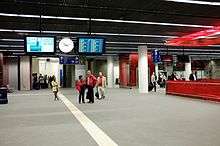





- Alternatively, Brussels can be reached by train much more cheaply via Zaventem village (dorp) station, which is within easy walking distance from the airport. At €3, the fare is three times cheaper than the ticket from Brussels Airport Station to the city. This is because the expensive Diabolo Surcharge on airport trains does not apply here. Therefore, you can also travel this way to a farther destination using a Go Pass or Rail Pass without the need to pay the Diabolo Surcharge. Zaventem dorp station is served by frequent local trains to all Brussels stations, taking roughly the same amount of time as the airport trains (15-20 minutes to Central Station). In order to reach Zaventem dorp station from the airport, go to the bus parking on level 0 and walk towards the end of it, where the airport bicycle lane starts. Follow the airport bicycle lane (marked in red) through the small car park and along the highway for about 700 metres until the first crosswalk at the roundabout. Cross the road to the left and walk into the street leading into the village (Vilvoordelaan). Keep going straight ahead for another 800 metres until you reach the railway station's back entrance.
- Coming from Brussels, exit Zaventem station through the back entrance on the northern side (the left in the direction of driving from Brussels). Walk straight north on Vilvoordelaan for about 800 metres until you reach the airport highway overpass, where you cross under and turn right onto the airport bicycle lane indicated with 'Terminal'. Follow the 'Terminal' bicycle lane for about 700 metres along the highway until you arrive at the airport bus parking on level 0, where you can enter the Terminal.



- Taxis to the center cost around €35. Taxis bleus/blauw (blue): +32 2 268 0000, Taxis Autolux: +32 2 411 4142, Taxis verts/groen (green): +32 2 349 4949. Beware of "waiting" charges if your flight is delayed and you pre-ordered a cab, some companies charge you parking fees + €25-30/hour for waiting. Always confirm the final charge with your driver before getting in the car. It is not uncommon for drivers to rip you off and charge €80 to go to the center, especially if they realize that it is your first time in Brussels and don't know your way around.
Left luggage facilities
Brussels Airport has a luggage locker service (Level 0) where you can leave luggage for a fixed duration. The lockers say that you will have to retrieve your bags within 72 hours or else they will be removed, but they are actually moved to the room next door and stored until you retrieve them. This is a useful facility for people wanting to stow away big suitcases somewhere safe. The rate is €7.50 per 24 hours. You must pay in coins, a change machine is nearby.
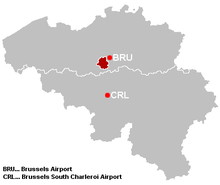
Brussels South Charleroi Airport
🌍
![]()
To travel between the airport and the city:










- Taxis from the airport to the city center cost a fixed price of €90. For the return trip to Charleroi you can book in advance a Charleroi-based taxi (€90). Taxis operating from Brussels use a higher fare and will take you to the airport for a fixed price of €120 or based on the meter up to €170.
Other airports
High speed rail and the central location of Brussels amid many major European cities make it entirely feasible to fly into several other airports and take the train from there. Depending on your itinerary, this may be both faster and cheaper, as connections may align better.







By train
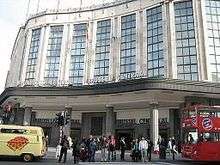
Brussels has five main railway stations:
- 🌍

- 🌍

- 🌍

- 🌍

- 🌍

Apart from the above, there are also stations of Brussels-Congress, Brussels-Chapel and Brussels-West, as well as stations in municipalities of the Brussels region that do not have "Brussels" in their name (e.g. Schaerbeek, Evere) which only see limited local service by RER trains.
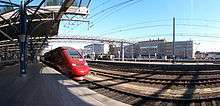
International train services to Belgium include:







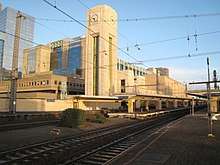
Arriving by train from within Belgium
Belgium has one of the most dense and best developed railway networks in Europe. Domestic trains are operated by the national railway operator ![]()
Frequencies and approximate travel times from Brussels Central station to selected cities in Belgium:
- Antwerp - 6x/hour, 40min-1hr 15min
- Arlon - 1xhour, 2hr 50min
- Bruges - 2x/hour, below 1hr 10min (the service to Kortrijk also continues to Bruges, but it takes twice as much time)
- Charleroi - 2x/hour, 1 hour
- Dinant - 1x/hour from Brussels-Schuman (not Central), 1.5 hours (you can also go from Central to Namur and change to Dinant there, travel time is longer by 15 minutes that way)
- Gent - 6x/hour, 40min-1hr 10min
- Kortrijk - 3x/hour 1hr 20min-1h45min (plus one extra connection per hour with a change Gent, 1hr 20min)
- Leuven - 5x/hour, 25 min
- Liege - 2x/hour, 1hr -1hr 30min
- Mechelen - 7x/hour, 25-30 min
- Namur - 2x/hour, 1hr 10min (+1/hour from Brussels-Schuman, same travel time)
- Ostend - 2x/hour, 1hr 20min (or with a change in Gent - 2x/hour, 1hr 40min)
- Waterloo - 2x/hour direct local train, 30min (or via Braine-L'Alleud, with a change from Intercity to local train - 2x/hour, total travel time below 40min)
There is also a fairly new suburban rail system (Brussels Regional Express Network, in French Réseau express régional (RER) and in Dutch Gewestelijk ExpresNet (GEN), or simply S train) that is like an S-Bahn, which serves nearby communities. Depending on the station, it can be faster or slower than an Intercity (IC) train, but as it is run by the national rail operator the price will be the same (fares are charged on the basis of distance for the most part). It will show up with the other trains when looking for tickets on the website, so you can see is it s a good fit for your journey or not.
All three major stations in Brussels are very busy and there are trains departing in many directions almost every minute. If you are on the platform, do check if the train you are boarding is the one you intend to, as it may be the one that departs just those few minutes are earlier. Be vigilant for last-minute platform changes. As the announcements for many trains (except for major international services and trains to Brussels Airport) are made in French and Dutch only, it is worthwhile to pay attention to departure displays. Always memorize the name of your destination in both French and Dutch to easily recognize it - the name as you may know it in English might not be used at all. Also note some trains are short, so at stations with long curved platforms such as at Brussel-Centraal you may not be able to see the train if you’re standing on the opposite end of the platform.
By bus
Several bus operators offer long-distance connections to Brussels. The station for long distance coach services is 🌍 Brussels North CCN in a narrow street to the north-west of the railway station bearing the same name. While waiting for a connecting coach, the 🌍 Starbucks inside the station can offer warmth and power sockets without the obligation to buy their overpriced drinks.
- 🌍 Eurolines, ☎ +32 2 274-1350, fax: +32 2 201-1140. Offers bus travel from many countries to Brussels, for example 8 hours from London Victoria station at €39. In Brussels, they stop outside the Gare du Nord-Noordstation and Gare du Midi-Zuidstation train stations. They have an office with toilets, heating, and a spare power socket under the staircase of the railway station left entrance.
- OUIBUS, ☎ +32 70 300-042. Runs a couch service between Paris, Lille and Brussels. Busses arrive at the Gare du Midi/Zuid Station.
- De Lijn, ☎ +32 70 220-200. The Flemish region (Dutch speaking) public bus service.
- TEC, ☎ +32 10 23-5353. The Walloon region (French speaking) public bus company.
- Flixbus. A German company with a network throughout most of Europe. Offers services to numerous German destinations, Paris, Rotterdam, Amsterdam, Bratislava and London. Unlike Eurolines they do not have an office in the station, but they routinely set up a mobile info desk manned by staff in easily recognizable bright green outfits, somewhere along the boarding area.
- RegioJet (Student Agency). A Czech company offering coach services from Czechia and Slovakia to a number of destinations around Europe. Their service from Prague to London stops each morning at Gare du Midi and each evening on the way back. The company also offers combined bus + train tickets to/from destinations not served by buses directly, which may be cheaper than getting a split ticket.
By tram
Brussels is connected to Tervuren by tram 44 , following the trajectory of the Tervuren Avenue (Tervurenlaan) between 🌍 Tervuren station 44 and 🌍 Montgomery 1 7 25 27 39 44 61 80 81 N06 metro station. The scenic 10 km long journey through the Sonian Forest takes about 20 minutes, with a frequency of 5 trams per hour. A single ticket is €2.10, and allows you to get off at any station along the way and back on the next tram within the ticket validity of an hour. Tickets can be purchased in Tervuren station or from the tram driver at an additional fee.
Brussels can also be reached from Kraainem by tram 39 , which connects Montgomery metro station to the 🌍 Ban-Eik 39 station and traverses Kraainem halfway. Get on at stop 🌍 Wilderozenweg 39 , on a walking distance of Kraainem's tourist attractions, and take tram 39 direction Montgomery. Travel time is approx. 15 minutes. As with tram 44 , a ticket costs €2.10, can be purchased in advance or from the tram driver at an additional fee, and remains valid for an hour.
By metro
Brussels metro line 1 extends until Kraainem, from which Brussels can be reached from 🌍 Kraainem 1 76 77 79 N05 metro station which is closest to Kraainem's tourist attractions, and from 🌍 Stokkel 1 39 metro station closer to Kraainem's commercial district Stokkel. Tavel time to the Brussels Grand Place from Kraainem station is about 25 minutes. A single ticket Jump costs €2.10. Tickets must be purchased from a GO vending machine in either Kraainem or Stokkel metro station, and can only be paid with euro coins or Maestro compatible cards. Bills are not accepted.
By bicycle
Brussels is the third capital on Eurovelo Route 5, which starts in London, through Brussels and Switzerland and ends in southern Italy. A number of other international and national cycle routes converge on Brussels.
Get around
On foot
Most sights in Brussels are fairly close together, within reasonable walking distance of each other. The oldest part of town can have uneven cobblestone roads, but the rest of the city is fairly easy to walk. A zone of 50 hectares in the city center is reserved for pedestrians, the second largest in Europe after Venice. Brussels has many wet days, and in winter small amounts of snow can make the ground slushy, so water-resistant footwear is a must if you will be out walking all day.
By bicycle
Bicycles are an excellent way to get from the city center to attractions outside the 'pentagone'. Although the Brussels weather isn't always equally favorable for cyling, bikes are often faster than public transport, particuarly for short distances. The cycling infrastructure is fairly poorly developed in comparison to cities of similar size like Amsterdam or Bristol, and the elevation of Brussels might be challenging to inexperienced cyclists. Brussels' most valuable transport asset is, arguably, the Villo bicycle sharing system.
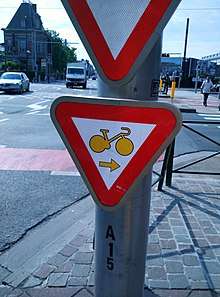
To encourage cycling through the city, cyclists are granted some privileges in Brussels traffic. Most notably, cyclists are allowed to drive either way in one-way streets. They are allowed to drive through the car-free zone in the city center, the largest in Europe after Venice. At intersections marked with a triangular sign with a cycle icon and a right arrow, cyclists are allowed to turn right at any time, ignoring red traffic lights.
Villo
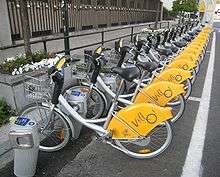
Villo is Brussels' public bicycle sharing system. It consists of 5 000 bicycles in the Brussels capital region, making it one of the largest in the world, with an infrastructure of 360 stations. Cycles can be rented out in any station and returned to the same or any other station, making it a convenient solution for point-to-point travel (as opposed to the ![]()
Villo bicycles are well equipped to deal with the poor Belgian roads: they have punction-resistant tires and a covered chain drive, and are in addition also equipped with a basket for cargo transport and automatic lights. Each bike has 7 gears and dual disc brakes to tackle hills around the city and reach destinations with higher elevation. The frame is rather heavy, though,accounting to a total weight of 22 kg. A decent physical condition is recommended!
To rent a Villo, a ticket must be purchased at a station. Not all stations issue tickets, which leads to confusion. Tickets are available for 1 or 3 days, and permit an unlimited number of rides. With a cost of €1.60 per day, this makes Villo the cheapest method of transportation after walking. Week passes are also available at €7.65. As Villo is intended for short trips, you will be billed €0.50 per half hour after the first half hour (the first half hour being free). This is of course easily avoided by returning your bike to a station before the first half hour expires, and immediately renting another bike from the same station, resetting the counter.
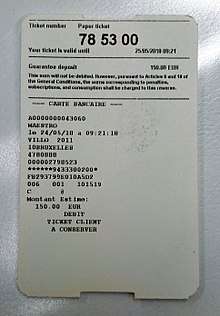
Purchasing a ticket goes as follows:
- Find a station that issues tickets, press the 5 button to change the language to English.
- Initiate the procedure to buy a ticket, and press 0 to get to the end of the EULA text. The response time of the controllers is very low, so give it a few seconds between every button push.
- Choose a 4-digit PIN code and repeat it. This will be your 'password'.
- A €150 deposit fee must be paid by card. You can only buy one ticket per card, and only if you have at least €150 available on the account.
- The ticket will be issued, after which you can rent a bike directly.
When choosing a bike, look at the orientation of the saddles. The convention among users is that, if a bike is defective, the saddle is lowered and its direction reversed. So don't try to rent out bikes with a reversed saddle. Likewise, if you notice your bike has a defect, then return it to the station and revese its saddle to notify other users. Unless there is obvious evidence of vandalism, minor damages (flat tires, broken chains, etc.) will not be billed to your account.
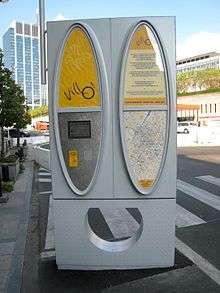
When returning your bike to a station, always wait for the double beep and green light on the post you returned the bike to. Long beeps indicate that the bike is not placed incorrectly. After the double beep, the bike should be locked again. If you don't return it correctly and the bike is stolen, €150 will be billed to your account!
After purchasing a ticket, bikes can be rented out from any station by typing the 6-digit subscriber number on the ticket into the station's kiosk, followed by the 4-digit 'password'.
OBike
Since September 2017, the Singaporean free floating bike rental service OBike offers an alternative service to Villo. Unlike Villo, OBike does not use a system of stations. Instead, each bike is equipped with a bluetooth transponder which allows them to be unlocked by subscribers with a compatible bluetooth transponder.
With a fare rate of €1 per 30 minutes, OBike is more expensive than Villo, particularly when you plan to cycle often. Users must register online (which requires internet access), and payments can only be made with a credit card. These contraints, in addition to the higher costs, make OBike less convenient than Villo.
By metro, tram, or bus
Public transport in Brussels can be confusing because different transport companies are active in the city. The dominant operator is the Brussels regional public transport operator STIB-MIVB (+32 70 232-000; €0.30/min). Some buses from Flemish regional transport operator De Lijn connect Brussels to surrounding Flemish cities, but their tickets are not compatible with MIVB tickets. Occasionally even buses from the Walloon regional operator TEC venture into the city, and again, their tickets are incompatible.
As long as you stay on the MIVB network — which roughly spans the entire Brussels capital region — a single ticket gives you access to all metro, tram and bus lines for the duration of 1 hour with as many transfers as needed to reach your destination. Since Brussels is a fairly small city, in practice, you can get anywhere in under an hour so the time limit will rarely be an issue.
Tickets are sold through reusable plastic cards (gray MoBIB cards) or disposable paper RFID cards. Should you stay longer than a few days in Belgium, it may be worth investing in a MoBIB card for €5, which are available for purchase at major metro stations and the 3 axis ![]()
To validate a ticket, either MoBIB or paper RFID ticket, push it against the red card readers within the white circle until it beeps, and the screen lights up green. You must validate your ticket on the first vehicle you enter and at each transfer afterwards. On buses and trams, the card readers are in the vehicles, whereas metro and underground tram stations have card readers with electronic gates at their entrances. If the card reader lights up red, it means there is no valid ticket on your card, possibly because the 1-hour time window has expired. At some stations, you need to validate again to leave the station. Groups of travelers can share a single MoBIB card if it has multiple tickets available, like 5- or 10-journey tickets. If you're with a group of 3, for example, simply tick the MoBIB card against the card reader 3 times to validate 3 journeys at once. At each transfer, you must again validate it 3 times. Groups must stay together during travel, since ticket checks are carried out routinely, and you must be able to present a validated ticket at any time. Failure to do so will result in a fine of €100.
Since buses and trams tend to get stuck in traffic, metro and underground tram lines are the fastest form of public transport. Most attractions can be reached by metro and a short walk. The metro in Brussels is quite clean and safe compared to most metro systems. Metro entrances are marked by big ![]()
In addition to the 4 metro lines there are also 2 underground tram lines 3 and 4 roughly running north-south, and connecting the North and South railway stations with the Grand Place and most of the city center attractions.
Metro and underground tram stations are often a warm and dry refuge from the wet and cold weather in Brussels, and typically offer small convenience shops or coffee shops like Starbucks and the likes to sit out heavy showers.
By train
The S-train can also be used for travel in the city. It is best for taking journeys from the center or a major train station to the outer edges, or the other way around. Some areas, especially in the north east, are easier to get to this way.
By scooter
If you have a driver's license, then scooters may be a less physically exhausting alternative to bicycles to get around the city. 🌍 Scooty is a network of electric scooters available for rental throughout the city. Following a free roaming model, scooters can be found on public places in the city, and unlocked remotely by subscribers. After use, the scooter may be left at any public place. Although convenient considering Brussels' elevation, scooter rental is more expensive than Villo at €0.25/minute. The scheme requires registration online and a suitable transponder, similar to OBike.
See
- Individual listings can be found in Brussels's district articles
Its rich history left Brussels dotted with countless landmarks, some of architectural beauty, others of monumental proportions. In the medieval centre, nearly every building has its own story worth exploring! The surrounding Pentagon, roughly corresponding to the outline of Brussels in the Renaissance, adds many more attractions to the list of must-see attractions. When the weather gets unpredictable, over 80 museums in the Brussels Capital Region offer indoor excitement when rain prevents outdoor activities.

The most iconic sight in Brussels is its central square, the 🌍
Grand Place, widely regarded as the most beautiful square in the world, and Brussels most famous ![]()

Over time, a flourishing commerce developed outside the first city walls, of which the Black Tower is one of the last remnants. The former docks around the Church of St. Catherine have been converted into fountains, but have kept their reputation for best fish restaurants in the city. The nearby Beguinage and its church tell the story of the development of the city up to French occupation at the end of the 18th century. The 🌍 cathedral dates from the same period, and as a nearly exact copy of the Notre Dame of Paris, it is well worth a visit because, unlike its more famous Parisian counterpart, entrance here is free, and there are usually no waiting lines! The Coudenberg Museum and Bruxella 1238 take visitors underground to explore the archaeological remains of Brussels history, for those fascinated by Brussels early history. The Halle Gate, now a museum, is the last surviving gate of Brussels second city walls.

From the Belgian independence in 1830 onward, Brussels quickly transformed into the modern capital it was envisoned to be. Under supervision of kings Leopold I and his son Leopold II, Brussels architect Joseph Poelaert initiated several monumental construction projects, most of which still stand today. Examples are the 🌍 Law Courts, the largest building in the world at the time of construction, overlooking the old city from Poelaert Square. The Church of Our Lady of Laeken to the north of the Pentagon and the Congress Column are also among his most famous work. The Royal Palace is just a short climb away and also dates from this period of architectural magnificence. The 🌍 Basilica of the Sacred Heart is the 5th largest church in the world, and a corner stone in art deco architecture.

The 🌍 Atomium, a 102 m tall sculpture of a 165 billion times magnified iron crystal, dominates the skyline of northern Brussels. It is the best known relic of the 1958 World's Fair, along with the Centenary Palace. Although only a few of the spheres are open to the public, the restaurant at the top offers an amazing view over Brussels. If you're lucky enough that the 🌍 Royal Greenhouses are open to the public, then don't hesitate to visit them.
.jpg)

To the east of the Pentagon is the European Quarter, the centre of political power in the European Union. Serving as the unofficial capital of the European Union, the second largest democracy in the world (after India), much of the legislation making processes take place in the 🌍 European Parliament and European Commission. Both can be visited, although tours tend to be rather formal. For a lighter experience, the Parlamentarium or House of European History are likely better tuned to younger audiences. The nearby 🌍 Cinquantenaire Park is worth a detour for its monumental arc, but also when the weather doesn't allow outdoor activities, the district has a lot to offer. The Museum for Natural Sciences hosts a complete herd of iguanodon skeletons, and is a must-see for adults and children alike, whereas the aviary hall of the Museum of Military History in the shadow of the Cinquantenaire Arc has original aircraft on display, ranging from civilian planes to jet fighters.
To keep balance with political powers, Brussels also hosts the NATO headquarters, the most powerful military alliance in the world, in the north-east district of the city. The nearby cemetery is home to many silent witnesses of the so called military victories. The railway museum Train World and nearby Tram Museum in the Woluwe district are top attractions for rail enthusiasts. Woluwe also has a lot to offer to architecture lovers, with the 🌍
Stoclet Palace and Solvay Residence recognized as ![]()
When strolling along architectural sights and museum display cases feels overwhelming, the Sonian Forest to the south of the city will offer a welcomed change of scenery. This vast section of nature, with lakes and century old beech trees, is protected as ![]()
If you're planning on visiting many attractions and museums, consider the advance purchase of a Brussels Card, which offers discounts at many attractions and free entrance to 40 of the most popular museums. It is available in 24 hr (€24), 48 hr (€36) and 72 hr (€42) versions, includes a free guidebook, free use of public transit (metro, bus, tram), and discounts at various shops, restaurants. It may not be worth it to those who already receive discounts (children, students, etc.). The card can be purchased on-line in advance for a discount, at the major tourist offices, and in some museums. Keep in mind however that many attractions have severely limited opening hours (usually from 09:00 until 17:00) when planning your visit, although sights like the Grand Place or Atomium can be enjoyed around the clock.
Do
- Individual listings can be found in Brussels's district articles
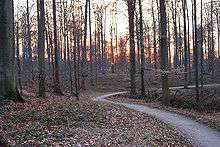
Brussels has a large variety of activities to offer, regardless of the weather. Strolling through the medieval centre and enjoying waffles or fries on the go is a favorite for locals and tourists. When passing the 🌍 Stock Exchange, sit down on the stairs along with the locals and have a chat. Keep an eye out for comic book murals, of which there are 43 different ones to discover around the city! Those fascinated by comic books may consider visiting the Museum of Figurines or the Marc Sleen Museum. Brussels can also be explored from underground through the 🌍 Sewer Museum, learning the history of the city while walking underneath its busy traffic.
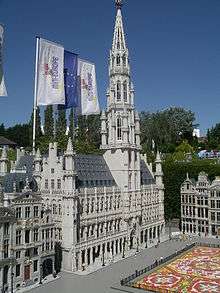
When weather permits, a walk through the 🌍
Ter Kameren Park or even the Sonian Forest, a ![]()
A confrontation with rain in Brussels humid climate is no reason for despair. If none of the 80 museums would be of interest then a visit to the 🌍 Planetarium or watching an action movie in 4D in the mega cinema complex 🌍 Kinepolis can be indoor alternatives. For more adventurous water fans, Nemo 33 offers a diving challenge in the second deepest swimming pool in the world.
If you prefer to get submerged into local culture, try one of the Brussels themed room escape games of 🌍 Enygma near the city centre, and puzzle your way out within the hour. For fans of Brussels many culinary delicacies, following a beer brewing or waffle baking workshop are tasty activities for an afternoon, alone or in a group. To keep up to date with what's going on, pick up a copy of local free city newspaper Zone 02. Another good free listings paper is Agenda, which is distributed together with the Dutch-language weekly Brussel Deze Week and has the notable advantage of being published in three languages (English, Dutch, French). You can find them in many cafés and restaurants around the city.
Buy

- Individual listings can be found in Brussels's district articles
Very few shops in Brussels open before 10:00, and most open about 10:30-11:00. Many shops are closed on Sunday and Monday.
Belgian specialities
Beer
- Beer Mania, 174-176 Chausse de Wavre-Waversesteenweg, Ixelles/Elsene. Claims to have a stock of over 400 beers, but has been overrun by beer tourists. The stock is extensive, but quite pricey in comparison to GB, Delhaize, or Carrefour. Beer Mania is a great place to find out of the ordinary beers.
- GB/Carrefour. Branches around the city carry a wide variety of beers, including almost all Trappist beer. Selection varies by store. The GB in Grand Place has a large selection and offers prices that are approximately a third of the prices in tourist shops.
- Delhaize. Similar to GB/Carrefour, but a tad more expensive.
- Match. Another store similar to GB/Carrefour, but has more of the unusual Belgian beers including Delirium.
- Cora. Two very large supermarkets on the outer limits of Brussels. They have a much larger choice of beers than Carrefour/ Delhaize/ Match and some very nice gift boxes but still with reasonable supermarket prices.
Chocolate
- Leonidas (branches across the city). very popular with the locals. Inexpensive and good quality, at €6.95 for 250 g (8.8 oz).
- Neuhaus (branches across the city). A bit more expensive than Leonidas and a bit higher quality. Very popular with the locals as well. It is also possible to get good discounts by buying directly at the shop outlet outside of the factory (Postweg 2, 1602 Vlezenbeek, tel: +32 2 568-23-10) which is just on the outer limits of Brussels, just a short walk away from the Erasme/ Erasmus metro station. Prices can go as low as €10 per kilo, however only the products that are specifically marked as having reduced prices are worth the trip, other products have the exact same price as in local shops.
- Mary (branches across the city). Excellent handmade chocolates, with this store originating from 1919.
- Passion Chocolat, 2/4 Rue Bodenbroek, also 20 Avenue Louis Gribaumont. Delicious chocolates, and they often offer free samples of 1-2 chocolates from their collection.
- Marcolini, 39 Place du Grand Sablon-Grote Zavel Plein. Arguably the best Belgian chocolates and priced accordingly. The country-specific products are difficult to find and quite worth the price.
- Wittamer, 6-12-13 Place du Grand Sablon-Grote Zavel Plein. Another excellent chocolate maker, with also a selection of macarons and cakes. They may however insist on a minimum 100g purchase for the chocolates.
- Chocopolis, 81 Rue du Marché aux Herbes-Grasmarkt (Between Grand Place and Central Station). Pick and choose your favorite type of chocolates, all at reasonable prices.
- Maison Renardy, 17 Rue de Dublinstraat, ☎ +32 2 514-30-17. A great boutique shop with delicious chocolate and friendly service. Stop by for a cup of tea or coffee, and get one of their chocolates free with your tea. Still peckish? You're able to bring a whole box home.
- Godiva (branches around the city). Not very popular and quite pricey.
- Chocolate bars. For the frugal, you can buy 100-200 gram gourmet bars of chocolate in grocery stores for about €1 each. Good brands to buy are Côte-d'Or and Jacques, both are Belgian.
Lace
- Belgian Lace. Among the best in the world. Several shops are at the Grand' Place-Grote Markt. Beware of some shops that sell Belgian lace even though production was outsourced abroad. Ask for a country of origin if purchasing around Grand Place.
Eat
- Individual listings can be found in Brussels's district articles
|
Chocolate until you drop Brussels is chock full of chocolates, but the ultimate indulgence for the chocoholic is Place du Grand Sablon-Grote Zavel Plein, where you will find three shops selling some of the best chocolate in the world: Neuhaus, Pierre Marcolini and Wittamer. Each store has its own specialties: Pierre Marcolini's take-away cakes and ice cream are reasons to be tempted, while Wittamer is the only one with a cafe on premises and also sells the ultimate hot chocolate. Passion Chocolat (20 Rue Vanderlindenstraat) is a bit out of the way but its artisan chocolate is worth a visit, and you can taste lots of it for free at the entrance. |
There is plenty of good eating to be had in Brussels. Most people concentrate on the three classics: mussels (moules in French and mosselen in Dutch), fries (frites in French and frieten in Dutch) and chocolate. A few more adventurous Bruxellois/Brusselse dishes include anguilles au vert/paling in 't groen (river eels in green sauce), meat balls in tomato sauce, stoemp (mashed vegetables and potatoes) and turbot waterzooi (turbot fish in cream and egg sauce). For dessert, try a Belgian waffle (wafel in Dutch and gauffre in French), also available in a square Brussels version dusted with powdered sugar, and choices of bananas, whipped cream and many other toppings. Although many prefer the round, caramelized version from Liège.
The matter over which establishment serves up the best frites (locally known as fritkots in Dutch and "friterie" in French) remains a matter of heated debate. Some argue that the best frites in Brussels are served at the fritkot near the Barriere de Saint-Gilles, while others defend St-Josse's Martin (Place Saint-Josse/Sint-Joostplein) as the prime purveyor of the authentic Brussels frite just as others claim Antoine (Place Jourdan/Jourdanplein) remains the king of the local french fry. No matter which fritkot you're at, try to be adventurous and have something other than ketchup or mayonnaise on your fries. Of the selection of bizarre sauces you've never seen before, "andalouse" is probably the most popular with the locals.
Vegetarians can find at least one menu item at many, though not all, regular restaurants. Vegans will have a harder time, while the Veganizer BXL initiative is looking to widen their options, it’s best to head for the vegetarian-vegan restaurants.
Check the prices of food items before ordering, especially when servers make choices for you. It has been reported that tourists have to pay up to €7 for a litre of sparkling water, costing less than €0.70 in local stores.
Also beware of the 'Italian Restaurant Streets' in the tourist and shopping districts. These streets are lined with small Italian restaurants, some offering "3 course meals" for €12 or €13. They are all run by just a few shop owners and serve unappetizing store purchased food. They will not 'include service' as most all restaurants in Brussels do, and many tourists have reported getting scammed here, especially when not paying with exact change. A common practice is to present you a menu where prices aren't anything near the ones advertised in the windows. Be sure you ask why there is such a price difference before ordering and do not hesitate to leave if you do not agree with the price. If you were offered a drink and already sipped from your glass before receiving the menu (as is often the case) then just pay for the drink and leave.
Brussels' tourist restaurant gauntlet can be found in Rue des Bouchers-Beenhouwerstraat, just to the north of Grand Place. The place has a bad reputation for waiters imposing themselves on passers-by, trying to lure customers into their restaurant. The authorities are aware of this, and are trying to take measures. Some restaurants may also tempt you with cheap prices for the menus, but when seated, the item on the menu happens to be unavailable, and you're forced to accept another, noticeably more expensive dish. Often, the exaggerated price of the wines will also compensate for the attractive menu. Knowing this however, you may be able to negotiate a better deal before entering.
Drink

- Individual listings can be found in Brussels's district articles
Belgium is to beer what France is to wine: it is home to one of the greatest beer traditions in the world, and Brussels is a great place to sample some of the vast variety on offer. Typical beers of Brussels are gueuze (rather sour) and kriek (rather sweet, cherry based).
Smoking is prohibited in all bars. It is allowed to smoke on the outdoor parts that many bars install on the street during the warmer months.
A special drink only found in Brussels is the "half-en-half" ("half and half"). It's a mixture of white wine and champagne.
Sleep
- Individual listings can be found in Brussels's district articles
Hotel rates in Brussels can vary widely (especially at the upper end) depending on how many EU bigwigs happen to be in town. Good deals are often available on weekends and during the summer when the bureaucrats flee on vacation.
Stay safe
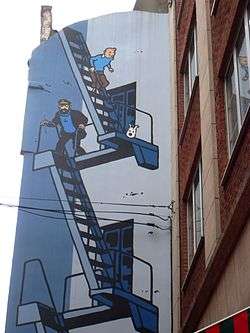
Brussels is increasingly dealing with the reputation of being a rather unsafe city by Western European standards; though it is by no means as dangerous as certain cities in the US or Latin America, Brussels does feel – and is in fact – more dangerous than other major European cities like Amsterdam or London.
Areas to watch out for
Generally speaking, tourists are unlikely to suffer too many safety issues in the city center, on major streets, and in much of East and South Brussels (So long as the basic precautions are taken). On the other hand, some suburban neighborhoods have a reputation of crime and decay, though most travelers are unlikely to visit them. The (subjective) safety of an area can change very fast in Brussels, so know where you're going when doing so at night and outside the city center. Ask a local for advice if possible. This is especially relevant for areas with nightlife such as Saint-Gilles, Matongé, Anneessens (around Place Fontainas), Molenbeek (next to the canal) and the Marolles.
This map gives an indication of the less attractive and inviting areas (in red), although the attractiveness and subjective safety of an area can change quickly street by street.
Pickpocketing
Pickpocketing is by far the most likely issue you will come across in Brussels, with the city frequently ranking high by European standards. Pickpocketing has been reported in nearly every neighborhood in Brussels. This activity is mostly carried out by teams in crowded tourist areas, in train and metro stations, and in parks (even during the daytime). Those who commit these petty crimes are really professional. Therefore, as usual, it's better to not unnecessarily show valuables in public, especially when looking as a tourist.
Parks
In the Parc de Bruxelles/Warandepark, between the Royal Palace and the Belgian Parliament, criminals have been known to threaten their victims with violence. If you are robbed, there is a police station right next to the gate in front of the Belgian Parliament (on the right side when leaving the park, hidden in the bushes) where experienced policemen will help you. Most of them speak French, Dutch and English well.
Most big parks don't have any (sufficient) lighting. Examples are those around the Atomium: the Laeken and Osseghem park. Although they are mostly just deserted at night, it's always better to be careful, especially since there are some rougher neighborhoods nearby.
The Parc Maximilien/Maximiliaanpark (just west of North Station) is located near the Immigration Office, and is often used by migrants to spend the night while waiting to apply for asylum, moving to another country or for various reasons. It's unlikely a tourist would wander there, but it's still better avoided.
Train stations
- The areas immediately surrounding the Brussels Midi-Zuid train station are among the poorest in the city: it is not advised to wander there alone at night. The station is among the biggest pickpocketing hotspots in Europe.
- The same applies to the Nord-Noord train station; do not venture too far away from the Northern Quarter (the business district that surrounds the Nord-Noord station), as several rough areas are nearby, including the city's red light district.
- The Brussels-Central station is also a known pickpocketing hotspot. There are many homeless people begging around the station as well, but rarely in an aggressive way.
Miscellaneous
- As in Paris or Berlin, people of the Jewish faith should think twice before wearing identifiably Jewish symbols.
- Belgians tend to drive poorly, and this goes double for Brussels. Always look before crossing and do your best to refrain from jaywalking.
- With Belgium being the land of beers, drunken behaviors are to be expected in Brussels, especially when football games are on, during weekends, and on certain holidays (St. Patrick’s Day, National Holiday, etc.). Just keep an eye out and you should be fine.
Cope
The most widely read English magazine is The Bulletin which, apart from covering Belgian and EU news, also offers arts and lifestyle stories, as well as in-depth events listings and a TV guide.
Work out
- Fitness Palace, Rogier van der Weydenstraat 3 (Zuidpaleis (Palais du Midi)), ☎ +32 2 5132616, e-mail: info@fitnesspalace.be. 10:30-22:00. €8 daypass, €6 offpeak.
Embassies
At present, the capital city of Brussels hosts 185 embassies. Foreign affairs keeps an updated list of foreign representations.












Go next
Visit the following Belgian towns and cities, all within a two-hour drive of Brussels:
- Kraainem - Bordering Brussels to the east. Architecture from the 16th to 18th century, primarily interesting for history and architecture enthusiasts.
- Tervuren - South-east of Brussels, on the outskirts of the Sonian Forest, a

- Waterloo - About 15 km south of Brussels. Visit where Wellington and Bluecher faced Napoleon for an ultimate battle that changed Europe's face forever. Further south, don't miss the Abbey of Villers-la-Ville.
- Sint-Pieters-Leeuw - About 10 km south of Brussels. Visit the nature reserve with Galloway cattle (not in winter) so near to Brussels
- Mechelen - About 35 km NE of Brussels.
- Leuven - About 30 km east of Brussels.
- Antwerp - About 55 km north of Brussels.
- Bruges - About 100 km NW of Brussels.
- Charleroi - About 60 km south of Brussels
- Ghent - About 60 km NW of Brussels.
- Namur - About 60 km SE of Brussels.
- Tournai - About 90 km west of Brussels.
- Mons - About 70 km south of Brussels.
You can also get to any of the following 'foreign' cities from Brussels within a few hours without the use of a plane:
Amsterdam/Rotterdam/The Hague/Utrecht (train or car), Luxembourg (car or train), Paris (train - longer by car), London (by train), Aachen (train or car), Maastricht (one hour by train) Lille (less than an hour by train or car), Cologne/Bonn (train or car), Frankfurt (train - longer by car)